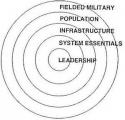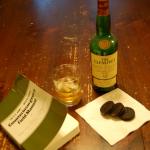Another concept from law enforcement that translates well into the COE is that of displacement. It doesn't really describe a Center of Gravity, but just as crime displacement sometimes makes resolving the crime/disorder triangle nearly impossible, I feel it demonstrates why it is so difficult to pin down a COG for us to exploit. In conducting analysis, there are essentially six types of displacement:
Temporal: Shift in time. The bad guys aren't stupid, and operational patterns tend to be easy to detect. Shaking up those patterns puts a kink in their system - temporarily. Too often what is thought to be "random" is simply an irregular pattern; and once the bad guys pick it up the dynamic starts all over again.
It sounds too simple - everyone knows not to set patterns. But I could relate plenty of true stories of unit commanders doing very stupid things with schedules in the hot zone.
Target: Shift from hard targets to soft targets within the same area. But then again, it isn't always the classic hard vs soft target issue. Once a pattern is set of hitting police recruiting centers, mix it up with a strike on a mosque or increase attacks directed at the coalition. Targets become hard once they are known to be targets; and thus they shift resources away from other potential targets. Hit the other target, a knee-jerk shift in finite security resources occurs, move to a different target set. Short target cycles are very productive for the bad guys.
Spatial: Shift from highly protected areas to less protected areas. This ties in closely with "Target Displacement" and has been discussed at length on SWC. In the end, without enough coalition and indig security forces to saturate the country, the bad guys will always be able to shift their AO.
Tactical: TTPs shift to meet counter-measures. This needs no explaining. We have an excellent lessons-learned system in-place to track and analyze shifting TTPs. It just a damn shame that more of our guys don't use the information provided.
Perpetrator: New bad guys replace the old. The "beheading" strategy doesn't work too well in disrupting the bad guys. Of course, that's a general statement, and there are exceptions. But, as a rule, disruptions are temporary - there always seems to be another ready to take his place. Going back to Kilcullen's article, this is one of the most significant differences between "classic" insurgency and the COE. The strict hierarchies that characterized many revolutionary organizations simply do not exist. There will be no equivalent of what happened to Sendero Luminoso or the PKK when their leaders were captured.
Type of Crime: Bad guys shift to an entirely different MO once the reward-to-risk ratio is against them. In the larger context, this may reflect an organization's shift from using primarily terrorist tactics to fighting as insurgents - or a group reducing their insurgent activity while focusing on narcotics trafficking.
This only provides some very brief tactical/operational examples of the application of displacement. As I'm sure is clear to all of you, the six types don't really stand alone - when you look at the operational environment through the analytic lens of displacement you'll see that there's quite a bit of overlap. You should also be able to see that far too often we are the ones reacting, and the bad guys are doing the exploiting.











Bookmarks